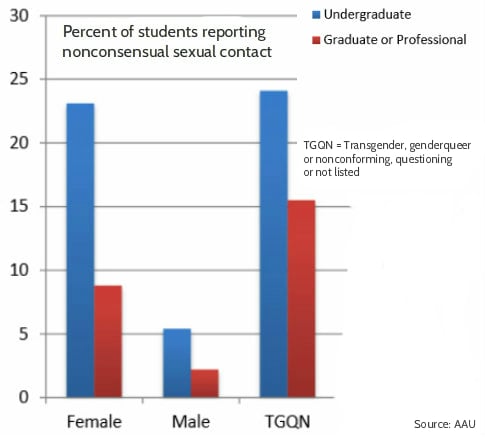You have /5 articles left.
Sign up for a free account or log in.

Photo Illustration by Jake New
Photo of transgender flag by Torbak Hopper | Flickr
One in four transgender students have experienced sexual assault since enrolling in college, according to a survey created by the Association of American Universities that provides one of the clearest looks yet at the prevalence of sexual violence among this especially vulnerable and often overlooked population of students.
The survey -- which was released Monday and also found high rates of sexual assault among female, gay and lesbian undergraduates -- included responses from 150,000 students at 27 institutions. Nearly 1,400 of the respondents said they identified as what the survey called “transgender, genderqueer, questioning or not listed” (TGQN).
“Very few campus surveys have produced statistically reliable estimates for those who identify as TGQN because they constitute a very small percentage of the population,” the researchers wrote in their summary of the survey, noting that TGQN students accounted for about 1.5 percent of respondents. “While this is a small percentage, the large number of responses to the AAU survey permits estimating rates for this group with adequate statistical precision.”
The survey used a broad definition of sexual assault, referred to as nonconsensual sexual contact, that included sexual touching or kissing as well as penetration. The study also includes separate data specifically about sexual assault involving penetration.
More than 24 percent of undergraduate students identifying as TGQN reported experiencing nonconsensual sexual contact, a rate that is comparable to female undergraduate students. Both groups have rates that are about five times higher than male students. Nearly 14 percent of gay or lesbian students reported experiencing a sexual assault while in college.
Among graduate students, transgender students are at far higher risk than any other segment of the population, with 15.5 percent reporting that they have been sexually assaulted. Transgender undergraduate students also had the highest rates for sexual assault involving penetration. More than 12 percent of TGQN students said they had experienced this type of assault, as well as 8.3 percent of graduate students.

In addition, the survey asked students about incidents of sexual assault specifically involving a lack of affirmative consent, a definition of consent that a growing number of colleges are adopting. The survey asked if students experienced "penetration or oral sex without [their] active, ongoing voluntary agreement." Nearly 15 percent of students identifying as TGQN said they had been assaulted in this fashion, a rate higher than for nontransgender women.
Three-quarters of TGQN students reported experiencing sexual harassment, which the survey defined as including messages, pictures, jokes and other remarks. TGQN undergraduate students also had the highest rate of stalking (12.8 percent) and intimate partner violence (22.8 percent).
When asked if they thought it was likely that they would experience sexual assault or sexual misconduct on campus, 18 percent of TGQN students said it was very or extremely likely. Three-quarters of TGQN students said sexual assault was “a problem” at their institution.
“The high rates of sexual harassment indicate that campuses still have not done enough to manage their culture to allow TGQN students to feel welcome on campus,” Laura Dunn, founder of victims' advocacy group SurvJustice, said. “It is truly shameful and also suggests more efforts need to occur in middle and high school around sexual respect.”
Though dismayed by what the survey found, Dunn said she was “heartened” that it included questions specifically about transgender students.
Information about the prevalence of sexual violence among transgender college students is scarce, making it difficult to compare the AAU study with other studies. Indeed, there is lack of data about the transgender population, more generally, including its size. Information on who is committing the assaults -- whether the perpetrators are partners, acquaintances or strangers -- is even more scant. While most colleges do track how many students they have by gender, race and ethnicity, it is only a minority that ask whether they have lesbian, gay or transgender students, let alone consider their experiences.
The U.S. Department of Justice’s Office for Victims of Crime reports that half of all transgender people have experienced sexual violence sometime in their life, with most assaults occurring when they are children or young adults.
The National Center for Transgender Equality’s 2011 National Transgender Discrimination Survey found that 65 percent of respondents said they had experienced sexual assault, with 3 percent of respondents attending college reporting they had been assaulted. That survey -- which collected responses from 6,450 participants -- was not focused specifically on gathering responses of college students, however, and used a vaguer language than the AAU survey, asking if respondents had been “sexually assaulted or attacked.” Most researchers who study rates of sexual assault recommend using specific language about specific sexual acts.
More than two-thirds of those who reported being sexually assaulted in the 2011 survey said they attempted suicide after being attacked.
Genny Beemyn, director of the Stonewall Center at the University of Massachusetts at Amherst, said there’s little understanding of the true prevalence of sexual assault against transgender people because they “remain invisible,” including on many college campuses. That invisibility often leads to transgender students being left out of prevention and policy efforts, as well.
Few colleges, Beemyn said, include information directed at transgender students when discussing their responsibilities under the federal discrimination law Title IX. In 2014, the U.S. Department of Education released new guidance explicitly stating, “Title IX protects all students from sexual violence,” including transgender students.
“Students might be afraid to be out as being trans, but even when they are out and visible, they’re still largely invisible to campus administrators,” Beemyn said. “There is not the same level of awareness and education as there is for gay, lesbian and bisexual students, so there’s not much work being done to improve the climate. Nobody is really looking at what’s going on.”








